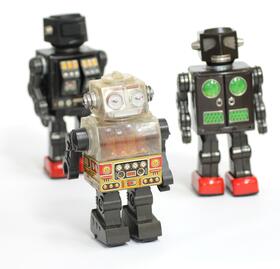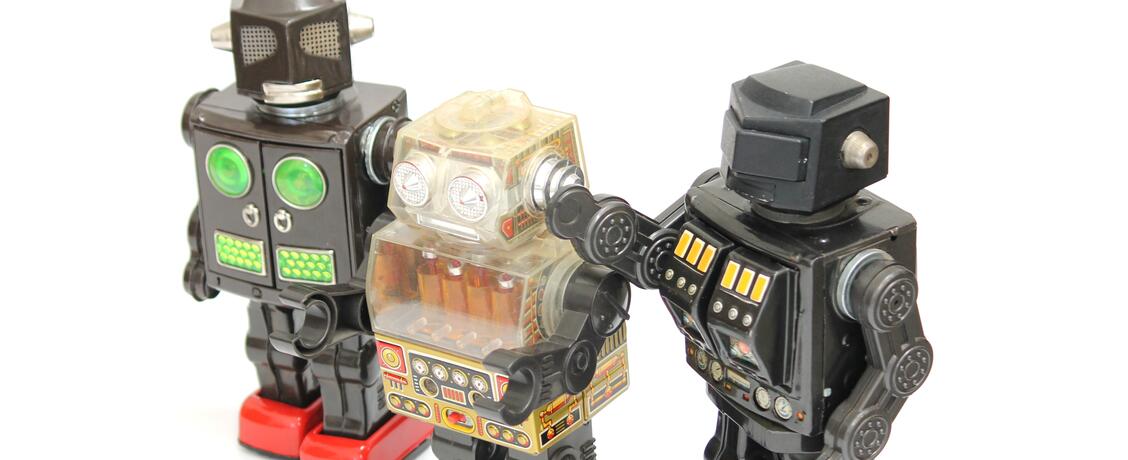Robots Rule, OK!
Robots Rule, OK!
By Elizabeth Talbot
News reports about AI abound in 2023; some worryingly pessimistic, some promising positivity for our future well-being, many of them totally baffling for most of us. Just 100 years ago it was the appearance of the first robot, AI’s precursor, that was causing a mix of excitement and dread around the developed world; but mainly excitement!
The word “robot” first appeared in 1921, in Karel Capek’s play “R.U.R”., or “Rossum’s Universal Robots”, and comes from the Czech, meaning “forced labour.” These characters were robots more in spirit than form because they looked like humans and were not made of metal. They were also murderous and so, from inception, Capek instilled the negative characteristics which have often, although not exclusively, been attributed to robot machines in much of the popular culture which has followed. However, robots are generally considered intelligent and can perform tasks autonomously, plus sense and manipulate their environment.
The earliest (modern) robots as we know them were created in the early 1950s by George C. Devol, an inventor from Louisville, Kentucky. Somewhere between 1954 and 1956 he invented and patented a reprogrammable manipulator called “Unimate,” from “Universal Automation.” Also in 1954, the first American-made robotic toy, known as Robert the Robot, appeared in the Sears Christmas Book. The very next year, Japan started exporting battery-operated robotic toys to the U.S. By the mid-1950’s, Japan had become the world’s primary toy manufacturer.
Then life began to imitate art, which at the time seemed to have stolen a march on reality. In 1958 at the Stanford Research Institute, Charles Rosen led a research team in developing a robot called “Shakey.” Shakey was far more advanced than the original Unimate, which was designed for specialized, industrial applications. Shakey could wheel around the room, observe the scene with his camera “eyes,” move across unfamiliar surroundings, and to a certain degree, respond to his environment. He was given his name because of his wobbly and clattering movements.
By the 1960’s, when the real space race was gathering pace, further influencing, and fuelling the imaginations of sci-fi comic-writers, illustrators, and the film industry, toy manufacturers wasted no time in being topical and creative, too. Toy robots proved very lucrative and as already noted, Japan was the lead producer in the world market at this time. One of the most iconic toy robots, released in 1966, was the Attacking Martian Robot, by Horikawa; it was their best-selling and best-loved robot. It was originally priced at $3.97 but can now fetch between £300 and four figures amongst collectors. It superseded the Engine Robot which was popular in 1964 and 1965 because it was more sophisticated: it had eye-catching styling and new actions. Advertisements in tempting toy catalogues of the mid ‘60’s describe how it “walks forward, stops, chest opens, and fires”, and rarer models had flashing eyes as well. These various features were copied by other toy producers and so, “Attacking Martian was a major influence on public perceptions of robots in the real world” states the Science Museum Group website.
It was powered by two “D” cell batteries (not supplied) and could be found in different colour ways, including silver and later, in a scarce gold colour. Interpreting just how many colour variations are possible can become very technical, including whether the on/off switch is red, black, or opaque or transparent green (plus whether there are plastic components interchanged with metal pieces or whether the arm is moving or non-moving, etc) but all such details are of huge significance to avid enthusiasts. If an example survives with its original box, this can be either a Japanese-issue or English; and those still retaining their shoulder tag, a feature issued for the Japanese home market only, are almost impossible to come by. Production of Attacking Martian ceased in 1969.
Horikawa was formed in Tokyo in 1959. It used to be thought of as a manufacturer of tin toys but is now believed to have been simply a seller of products supplied by Metal House, a company which was established in Marumiya in 1943. Initially the robots Horikawa issued were clockwork and are often referred to as their 1st. generation robots. Later these were replaced by a ‘2nd. generation’ which were battery driven.
Horikawa is known for providing a long list of popular toys, primarily space toys, and notably space robots. One of the earliest big successes in the mid-to late 1950’s was Nomura’s Zoomer Robot, followed by a series of toys based upon the Robby the Robot character brought to life by MGM’s 1956 movie “Forbidden Planet”, such as Piston Robot and Mechanized Robot. These are highly sought after today, as are other well-known Horikawa toy robots including Smoking Spaceman, Machine Robot, Mr. Zerox, Fighting Robot, and of course, Attacking Martian.
After enjoying a long run of non-stop growth from the late 1950’s through to the mid-1970’s, the Japanese tin toy industry found the 1980’s a difficult era in which to survive. Changing tastes, lower-priced competition from other countries, and increasingly aggressive toy safety regulations, all led to a massive downturn in the demand for tin toys. Most companies which had enjoyed big successes across the world were out of business by the end of the decade, including Horikawa.
Rupert Willows, toy specialist and auctioneer at Diss Auction Rooms, is very excited to have fine examples of 1960’s toy robots, including a boxed Attacking Martian in his next sale on Thursday 29 June. “My expectation is that they will attract a lot of interest and should sell very well. Such toys have an international following for many reasons and seem as topical as ever in our increasingly technical world.”
Illustrated catalogues, bidding instructions and further information at twgaze.co.uk.

